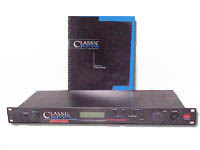Classic Keys
Classic Analog Keyboards

Overview After the roaring success of the Vintage Keys module in 1993, E-mu Systems decided to develop a low cost retro analog module - the Classic Keys . They achieved this by taking out the expensive digital filter chips and putting in 2 low cost FX chips. E-mu also used a remote power suppy, and reduced the number of analog outputs to two (four less DAC chips).
Classic Keys is a 32 voice multi-timbral sample based synthesizer module that plays classic analog keyboard instruments. It was released a few months after the Vintage Keys module as a cheaper solution to the quest for analog sounds. It uses exactly the same 249 samples, but the presets are different.
Presets This module contains hundreds of rich, warm textural sounds from a range of vintage keyboards. The list includes; Rhodes, Wurlitzer, Hammond, Prophet, Moog, ARP, Mellotron and Oberheim. Acoustic, digital and analog drum kits are also included. There are 512 presets, arranged as four banks of 128. Bank 0 and 1 are held in RAM and can be changed at any time. Bank 2 and 3 are stored in ROM and cannot be changed.
Expansion The Classic Keys module can not be expanded.
Filters Classic Keys has just a low pass tone control enabling you to brighten the sound from velocity or keyboard scaling. You have to rely on the dual effects section to sweeten the samples.
Effects There are 31 different effects (from Reverb, Echo to Flange) spread over two effects units which can be applied globally across the stereo outputs.
MIDI Implementation E-mu Systems finally implemented MIDI bank select, so you can call up all 512 presets via MIDI, and you can determine which bank is mapped to which MIDI bank number. There is also a Program Change Mapping Table to map the 512 patches to the first 128 available MIDI program change messages. MIDI Overflow can be used to pass notes beyond the basic 32 to another module. The module is 16 part multi-timbral when the Multi mode option is selected. Unfortuantely E-mu did not implement a means of storing multiple presets across MIDI channels. This feature, called HyperPresets, was eventually implemented in the Morpheus and UltraProteus.
Configuration The Classic Keys module implements a rather limited synthesizer architecture. There are two "oscillators" called Primary and Secondary Instruments. They can each replay any of the 249 16-bit sampled waveforms, and up to four of these Instrument pairs can be layered under on key. The waveforms are replayed first via a simple digital tone control, and finally a digitally controlled amplifier (DCA) and pan.
The amplifier is modified by a dedicated AHDSR envelope generator . There are also two independent LFO's (triangle, sawtooth, square, sine and random waveforms), and an auxiliary envelope generator (DADHSR), which can be patched into the Instruments, Low Pass Filter or DCA. There is also portamento, and cross fade between the two Instruments. Up to 8 sounds can be layered on each key, by linking four Presets.
Verdict A good low cost source of some analog keyboard sounds (and a DX7, electric bass sounds and a drum kit !), but not a replacement for the real thing (or even the new virtual analogs).
Diagnostics The Classic Keys has a full range of internal diagnostics, but beware they can cause speaker damage and the initialisation routine is a one way process.
To enter diagnostics mode, power on with both cursor keys held down. There are 13 modes, which test out all the various components inside the module.
To re-initialize your module, if it locks up, scroll down until you get to the "initialize" option. Hit enter and you will wipe out your user-definable patches and reset the module back to its factory state. Beware! Save your patches first!